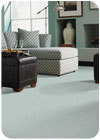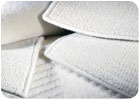
For all the changes seen recently in the carpet fiber business, one of the most significant developments goes beyond advanced product formulations. More and more, shoppers looking for new soft surface flooring are beginning to understand that fiber is to carpet what an engine is to a car. Given the rapidly evolving nature of carpet fiber technology and the ever-increasing focus on fashion in the flooring business, the materials used to make carpet are gaining a much higher profile. In short, consumers are starting to pop the hood and take a closer look at their floor coverings.
Those involved in the category say they welcome the scrutiny. They also note that it is a logical development. Much the way people shopping for apparel want to know something about the fabrics they buy-whether a shirt is dry clean only, for example - those looking for new flooring are likely to ask questions about the materials used to create their carpet.
"The type of fiber used in the carpet is very important to the finished product," says Amy Williams of Invista's Interiors division. A formidable name in the carpet fiber business, Invista is widely known in the industry for its Stainmaster products, as well as its Antron and Tactesse brands of nylon fiber. "The fiber can be engineered to affect the look and performance of carpet, including resistance to stains, matting, crushing and abrasive wear," she says.
While some of the chemical engineering involved may seem like rocket science, carpet fiber generally falls into one of two categories: natural and synthetic. Natural fiber is typically derived from wool. Synthetics are commonly made with polypropylene (commonly known as olefin), nylon or polyester. Both categories have their pros and cons.
For their part, naturals are usually soft and luxurious to the touch, but they are also more expensive to buy and far more prone to stains. Synthetics are more versatile - it's easier for a manufacturer to adjust a carpet's luster levels, for example - but the end result can sometimes feel artificial to the touch. It is also a material that is highly reliant on petroleum-derived raw materials. As such, prices can fluctuate greatly with the price of fuel. While oil-based products are certain to remain a key part of the industry for the foreseeable future, manufacturers are looking for ways to somehow become less reliant on oil-based products.

"Working with DuPont, Mohawk will be able to offer bio-based SmartStrand products sometime in 2006," assures Ed Williams, Mohawk's senior vp of marketing. "SmartStrand is an exclusive co-brand with DuPont, and will add even more value to Mohawk's carpets."
Certainly, the benefits found in the latest generation of carpet are highly compelling to many consumers. For example, Invista's newest entries include Antron fiber with StainResist technology, which is engineered to provide long-term performance and easier cleanup from spills. On the residential side, the supplier's ExtraBody fiber offers residential carpets greater thickness. Additionally, advances in the company's Tactesse nylon fiber are designed to make residential carpets softer without sacrificing durability.
Mohawk, for example, announced in early December a major development involving products made with DuPont's Sorona polymer. The polymer, which is used in the carpet maker's SmartStrand stain-resistant fiber, will no longer rely on oil-based chemicals but something far more natural: corn. Using an emerging technology that enables the Sorona polymer to be derived from fermented corn sugar, DuPont engineers say they will be able to offer Mohawk a groundbreaking new product that promises to have wide ranging implications for the future of carpeting.
"Working with DuPont, Mohawk will be able to offer bio-based SmartStrand products sometime in 2006," assures Ed Williams, Mohawk's senior vp of marketing. "SmartStrand is an exclusive co-brand with DuPont, and will add even more value to Mohawk's carpets."
Certainly, the benefits found in the latest generation of carpet are highly compelling to many consumers. For example, Invista's newest entries include Antron fiber with StainResist technology, which is engineered to provide long-term performance and easier cleanup from spills. On the residential side, the supplier's ExtraBody fiber offers residential carpets greater thickness. Additionally, advances in the company's Tactesse nylon fiber are designed to make residential carpets softer without sacrificing durability.

"With over 35 years of history with Anso and Zeftron, our nylon fibers continue to provide uncompromised value and aesthetic options," Leary says. Despite the optimistic outlook, he acknowledges that there is lingering concern about the U.S.
economy and increasing shortages of needed petrochemicals. The situation has prompted a number of suppliers, including Shaw, to increase wholesale prices.Other companies are also feeling the pinch. The management at Solutia, which makes Wear-Dated residential and Ultron commercial nylon fiber, is reaching out to top retailers to assure them that the price increases have been driven by external forces. The effort led to a meeting with the company that includes the Carpet One co-operative, CCA Global Partners.
"Solutia team members met with CCA Global leadership to explain the raw material dynamics driving carpet prices," recalls Christine B. Whittemore, director of in-store innovation for Wear-Dated Carpet Fiber. "Solutia is making similar presentations to Carpet One and Flooring America members across North America."
Yet despite the raw material shortages and rising prices, Solutia is busy developing new carpet fiber technologies, with much of the focus on creating softer fibers. Solutia's Traffic Control technology - which can be used in both Wear-Dated and Ultron fibers - aims to offer enhanced performance and a softer feel. The company's DuraSoft products also aim to make carpets softer. Solutia is taking the unprecedented step of kicking off these technologies via its first-ever "product road show and trend presentation" at Surfaces 2006, Whittemore says. "At Surfaces, we will show how our
fiber development efforts and technologies translate into actual end products."
She adds that increased cost associated with making synthetic carpet has opened the door for natural fiber makers to make their case.
"It's a great time for wool," she notes. "It's a natural, sustainable carpet fiber that's growing in demand. It is becoming more competitive in price, since rising oil prices have caused an increase in the cost of synthetics."

3M & Mohawk team up for a ‘total fiber protector'
Nearly a half century after 3M introduced Scotchgard and three decades after it was first used to shield carpet fiber from stains and soil, the company says it has build a better mousetrap. Working in conjunction with Mohawk Industries, 3M is launching Scotchgard Advanced Repel Technology. An addition to use in more than 80 Mohawk carpets featuring Solutia's Wear-Dated fiber, the product will also be used on wood flooring, a first for Scotchgard.3M describes Advanced Repel as a "total-fiber protector" that is specially formulated for Mohawk carpet and Wear-Dated fiber. It said the new formulation is "an integral part of the carpet manufacturing process that provides advanced deep-down protection" well suited to high-traffic areas including entryways, stairwells and hallways.
3M's national sales manager for Scotchgard, Jim Stevens said the company teamed up with Mohawk on an exclusive basis because it wanted a high-profile partner that would speed acceptance for improved Scotchgard products. The ability to work with a major manufacturer also gives 3M access to product mills for product development, he added.
"We created this arm-in-arm with Mohawk," said Stevens. "You can do a lot in the lab but without the mills it is just another laboratory prototype. Also working with Mohawk means that the product is being introduced with the backing of two strong brands. This gives us instant credibility."
The hope is that the two well-known band names will help establish the new version of Scotchgard as a selling point for flooring. Otherwise, Stevens said, quantifying or even demonstrating the stain-fighting attributes is difficult. "You might have a tough time seeing it right away because this is something that works very well in high traffic area and is something you can see over time."
Tom Lape, president of Mohawk Residential said Scotchgard Advanced Repel is a major step forward in stain-resistant flooring and compared to the co-branding strategy of other high profile joint ventures. "This is the most substantial commitment to a product platform in our industry's history," said Lape.
"We are putting together the products, technology, and marketing necessary to make this alignment one of the most valuable resources a floor covering dealer can have. Strong co-branded marketing platforms are proven to provide competitive advantages to channel partners," he continued. "Diet Coke and NutraSweet, Dell and Intel are high profile examples of this."

Report Abusive Comment